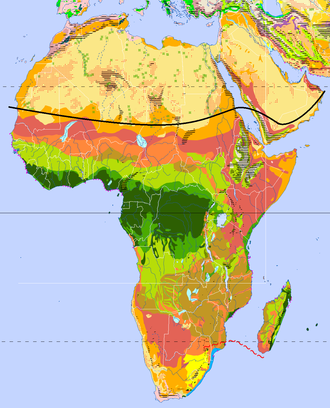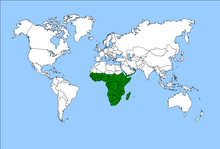Afrotropic
Afrotropis, also Ethiopis, is the faunal geographical name for Africa south of the Sahara . This area was formerly known as the Ethiopian Zone . Together with the Orientalis it forms the Palaeotropis , in which numerous common species of plants and animals or families occur. Examples of this are hornbills , elephants , screw tree plants and doum palms . The Afrotopis is the origin of the Afrotheria .
Subregions
The northern border of the Afrotropic Islands is bounded by the desert belt of North Africa. The southern part of the Arabian Peninsula is also part of the Afrotopis. Madagascar and the neighboring islands form a clearly distinguishable sub-region of this fauna zone in the Afrotropic Islands, which is home to numerous endemic animal species such as the lemurs . Madagascar and the Seychelles were originally part of the supercontinent Gondwana . The separation from the African continent occurred 150 million years ago. Other islands in the Indian Ocean, such as the Comoros and the Mascarene Islands, are of volcanic origin and formed much later.
At the southernmost tip of Africa is the Capensis , which is characterized by a Mediterranean climate. In contrast to the flora kingdom , which is characterized by many endemic species, the Capensis is not an independent sub-region of the Afrotropic fauna.
flora
The most important habitats of the Afrotropis are on the one hand the tropical rain and wet forests of Central Africa and West Africa, as well as the savannas and dry forests that surround them and shield them from the northern desert regions. These desert areas of the Sahara and southern Arabia form a transition zone to the Palearctic. In the south of Africa there are further desert areas with the Namib, the Karoo and the Kalahari.

| Trop. / ʅ subtropical rainforests | Trop. / ʅ subtropical Rain green wet forests | Tropical mountain rainforests & mountains Cloud forests | Rain-green moist savannahs |
| Tropical dry forests | Dry savannahs | Dornstrauch- u. Cactus savannas | Subtropical wet forests |
| Grass steppes u. Salt marshes | Shrub u. Dry steppes | Hot semi-deserts | Hot deserts |
| Hard foliage vegetation | Reed swamps u. flooding aquatic plants | Highland steppes u. -deserts | Subtropical dry forests |
| Moderate foliage and Floodplain forests | Mixed forest steppes | Mountain coniferous forests | Temperate coastal rainforests |
| Winter-cold semi-deserts | Winter cold deserts | Lichen u. Moostundra | Foliage and Mixed coniferous forests |
| Mountain tundra, alpine mats, etc. Heathens | |||
| ≡ = mountain ranges | ::: = desert regions without vegetation | : ¤ : = oasis vegetation (partly with delimitation) | ••• = mangrove coasts |
The endemic plant family of the Afrotropis include, for example, Oliniaceae , Heteropyxidaceae , Penaeaceae , Psiloxylaceae and Rhynchocalycaceae (order Myrtales ) and Sarcolaenaceae (order Malvales ).
fauna
Much of the fauna is similar to the Oriental, but there are also similarities with the Palearctic. Some endemic animal groups can be considered very ancient elements of the Afrotropic ecozone, as there are no fossil records for them from the Palearctic - a region about which most of the exchange has taken place in the recent past. These old forms are about the striped lizards , the caecilians , and freshwater mussels of the family Mutelidae . The Afrotropic Islands partly share these ancient forms with the Neotropical Region. A fact that points to the existing connection between the two continental plates and the great continent of Gondwana in the past.
Mammals
At the beginning of the New Age, Africa was partially isolated from all other continents and developed a particularly independent mammal fauna at that time. The groups of animals that arose here are now counted among the Afrotheria group. These include groups that are still endemic today, such as elephant shrews and aardvarks , but also groups that at times achieved global distribution, such as the proboscis and manatees .
Especially among mammals, the Afrotropic region has numerous similarities with the Oriental region, with which it is sometimes united to form the Paleotropic. Numerous families are endemic to both regions together, but each occur in different genera. Sun can be found among the apes , the species of chimpanzees ( Pan ) and gorillas ( Gorilla ) only in the Afrotropical, while orangutans ( Pongo ) and Gibbons (Hylobatidae) are endemic to the Oriental. The same applies to the vervet monkey relatives with monkeys ( Cercopithecus ), mandrill-like ( Mandrillus ) and mangaben in the Afrotopis and langurs, robed monkeys and snub-nosed monkeys in the Orientalis, to name just a selection. Further examples are the elephants with Loxodonta or Elephas , the rhinos with Diceros and Ceratotherium or Rhinoceros and Dicerorhinus or the horned bearers with genera such as Syncerus , Tragelaphus and Chonnochaetes in the Afrotropic or Bibos and Boselaphus in the Oriental.
The mammal families that are endemic to the Afrotropic today include the hippos , the giraffes , the elephant shrews , the otter shrews , golden mole , thorntail squirrels, aardvark, jumping hares, maned rats and mouse sleepers. Bears and deer, which were originally found in North Africa, are completely absent from the Afrotropic Islands. However, some, such as the hippos and giraffes, also occurred in South Africa until the Plio-Pleistocene.
Birds
The endemic bird families include the ostriches , the nectar birds , the secretaries , the guinea fowl and the long-winged parrots .
See also
literature
- Paul Müller: Biogeography . Ulmer, Stuttgart 1980, ISBN 3-8001-2459-9 .
Web links
Individual evidence
- ↑ Erich Thenius : Fundamentals of the fauna and distribution history of mammals . A historical animal geography. 2nd, completely revised edition, Gustav Fischer Verlag, Stuttgart 1980, ISBN 3-437-30312-0 (first edition under the title: Basic features of the history of the spread of mammals . Gustav Fischer Verlag, Jena 1972).
- ↑ a b c J. Illies: Tiergeographie. 2nd improved edition, (Edwin Fels, Ernst Weigt, Herbert Wilhelmy; original version: 1970). Georg Westermann Verlag, Braunschweig 1972, ISBN 3-14-160285-9 .

